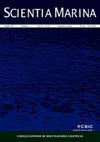Diel cycle of two recurrent fish sounds from mesophotic coral reefs
IF 0.9
4区 生物学
Q4 MARINE & FRESHWATER BIOLOGY
引用次数: 0
Abstract
Mesophotic coral ecosystems (MCEs) are the deepest part of tropical coral reefs, ranging from depths of 30 to over 170 m. Despite their significance, MCEs remain largely unexplored due to the challenges associated with accessing these depths. However, the application of passive acoustic monitoring methods (PAM) is a suitable approach for studying fish communities within these unique habitats. In French Polynesia, recent PAM studies have unveiled a higher occurrence of frequency-modulated fish sounds in MCEs than in shallower reef environments. This study aims to further enhance our understanding of fish sounds in MCEs by examining their diel patterns, focusing specifically on the two most abundant frequency-modulated fish sounds that were recorded at depths of 60 and 120 m at six Polynesian islands. Both sound types occurred predominantly during the beginning and the end of nocturnal periods. The presence and abundance of these sounds exhibited variation between the islands, highlighting potential regional disparities in vocal activity or the bathymetric distribution of the sound-producing species. By characterizing the diel cycles and bathymetric differences in relation to their geographical distribution, this study offers preliminary insights into identifying the potential sound-producing species.中生代珊瑚礁中两种经常性鱼声的昼夜周期
中生代珊瑚生态系统(MCEs)是热带珊瑚礁最深的部分,深度从 30 米到 170 多米不等。尽管中生代珊瑚生态系统非常重要,但由于进入这些深度所面临的挑战,大部分中生代珊瑚生态系统仍未被开发。然而,应用被动声学监测方法(PAM)是研究这些独特栖息地鱼类群落的合适方法。在法属波利尼西亚,最近的被动声学监测研究发现,与较浅的珊瑚礁环境相比,MCEs 中频率调制的鱼类声音出现率更高。本研究旨在通过研究鱼类声音的昼夜模式,进一步加深我们对多海洋生态系统中鱼类声音的了解,特别关注在波利尼西亚六个岛屿的 60 米和 120 米深处记录到的两种最丰富的频率调节鱼类声音。这两种声音主要出现在夜间的开始和结束阶段。这些声音的存在和丰富程度在不同岛屿之间表现出差异,突出表明了发声活动或发声物种的水深分布可能存在地区差异。通过分析昼夜周期和水深差异与其地理分布的关系,本研究为确定潜在的发声物种提供了初步见解。
本文章由计算机程序翻译,如有差异,请以英文原文为准。
求助全文
约1分钟内获得全文
求助全文
来源期刊

Scientia Marina
生物-海洋与淡水生物学
CiteScore
2.10
自引率
0.00%
发文量
21
审稿时长
6-12 weeks
期刊介绍:
Scientia Marina is the successor to Investigación Pesquera, a journal of marine sciences published since 1955 by the Institut de Ciències del Mar de Barcelona (CSIC). Scientia Marina is included in the Science Citation Index since 1998 and publishes original papers, reviews and comments concerning research in the following fields: Marine Biology and Ecology, Fisheries and Fisheries Ecology, Systematics, Faunistics and Marine Biogeography, Physical Oceanography, Chemical Oceanography, and Marine Geology. Emphasis is placed on articles of an interdisciplinary nature and of general interest.
 求助内容:
求助内容: 应助结果提醒方式:
应助结果提醒方式:


